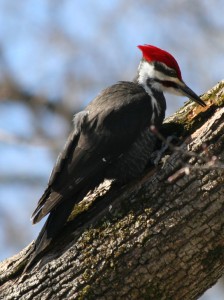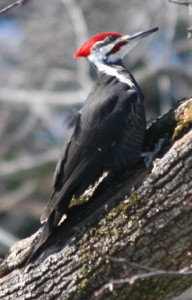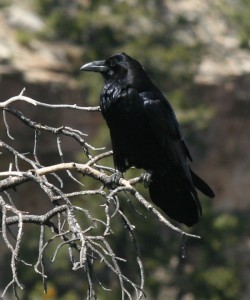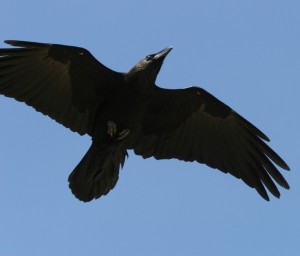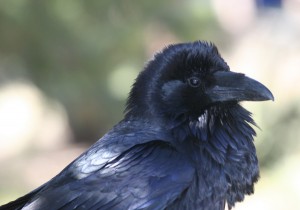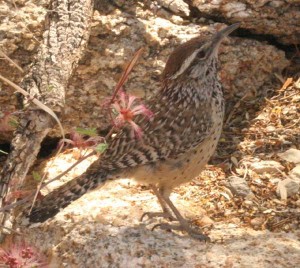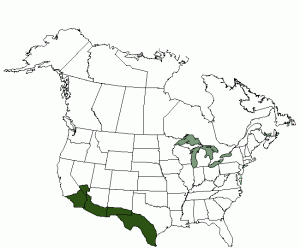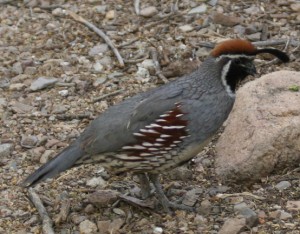General: Yellow-Bellied Sapsuckers (Sphyrapicus varius) are the small woodpeckers responsible for the neat rows of sap wells found drilled into trees across much of the southern and eastern United States and central Canada. These striking black and white birds can usually be found perched along tree trunks lapping up sap. Sapsucker populations are healthy and stable, earning the Yellow-Bellied Sapsucker the classification of Least Concern on the IUCN Red List.
Description: Yellow-Bellied Sapsuckers are small relative to other species of woodpeckers. They reach a mature length of 7” to 8.75” and weight of 1.5oz. to 1.9oz. They can be identified by their black and white, boldly patterned plumage (in scallops across the back,) yellow or buff-white undersides, red caps, and long white patches on the sides of folded wings (that open to a wing span of 13.5” to 15.7”1.) Additionally, Sapsuckers have white rumps, black eyelines and two white stripes stretching from the eyes and sides of the bill toward the black bib on the chest. Males differ from females by the presence of a red chin and throat, both of which appear pale or entirely white on females. Juvenile Sapsuckers have buff and dusky black barring on their backs with pale underparts and white rumps. Yellow-Bellied Sapsuckers have straight thick bills that act as chisels, brush-tipped tongues used for lapping up sap and catching insects, rigid, pointed tails, and crown feathers on the backs of their heads, which they raise to form peaks.
Yellow-Bellied Sapsuckers behave in a similar manner to other woodpeckers. Their flight consists of rises and falls, a swooping pattern used by other woodpeckers. They hop along tree trunks, leaning back against their supporting tail feathers when feeding or tending to sap wells, an activity that takes up at least half their time2. Their communicative behaviors are similar to those executed by other woodpecker species. Mating displays consist of lifting the head to reveal throat patches, chases, and tapping. Aggression is expressed through raised crests and ruffled tail and throat feathers, head swaying, and raised tails and bills.
Yellow-Bellied Sapsuckers produce a number of sounds. A kwee-urk is associated with breeding as well as territory defense. Threatened birds may also shrill. Breeding pairs also create quirk noises to strengthen their bonds. These noises are produced by scratching on trees. Repetitive week-week and wurp-wurp sounds are made between pairs or parents and juveniles. Excited birds make a nasal, mewing c-waan3. Like all woodpeckers, Sapsuckers create the unmistakable drumming noise while hammering against trees.
Yellow-Bellied Sapsuckers have been known to live to nearly 8 years old; however, in the wild they live an average of 6.5 years4.
Habitat: Yellow-Bellied Sapsuckers live in hardwood, mixed, and coniferous forests, at elevations up to 6500’.
In the spring and summer, they establish breeding grounds in young or regenerating forests that offer ample opportunities to bore sap wells. Nesting often occurs in groves of small trees, such as aspens. During the winter, Sapsuckers relocate to open hardwood or mixed woodlands. While Sapsuckers will inhabit a greater variety of habitats in the winter than in the spring or summer, they will not settle in an area that is entirely coniferous during winter months5.
Location: Yellow-Bellied Sapsuckers may be found throughout the central, northern and eastern United States and into central Canada. Sapsuckers are the only species of woodpecker in the eastern United States that is entirely migratory. Some Sapsuckers may stay in their breeding areas throughout the winter, especially in southern parts of their range, but most populations relocate to winter habitats, ranging from south of New England and the Great Lakes to southern parts of the United States, Mexico, the West Indies and parts of Central America. It is common for females to migrate farther than males. Sapsuckers have been found in Iceland, Britain and Ireland; however, Sapsuckers are not native to these geographic areas and these sightings are attributed to accidental relocation6.
Diet: Yellow-Bellied Sapsuckers can often be spotted sitting along tree trunks feeding from their sap wells. They harvest sap by boring two distinct types of holes in over 1,000 species of trees and woody plants (although they prefer trees that have sap with high sugar concentrations, such as maple, hickory and birch trees.) They select trees that are alive and actively producing sap, a behavior that sets them apart from other species of woodpeckers who tend to prefer dead wood.
Sapsucker’s systematic drilling starts in the spring, when narrow circular wells are bored deep into the trunk, providing access to sap flowing upward through the tree’s xylem (which sapsuckers reach by inserting their long bills.) The second type of well is shallower than the first and rectangular in shape, drilled into the phloem of the tree. These wells provide access to sap as it runs down from leaves once the tree has bloomed. Sapsuckers lap-up sap leaking from these wells. Because these secondary holes are shallow, they must be continually maintained with fresh drilling so sap can continue to flow. This sap has a sugar content of over 10%. New holes are drilled year round in both breeding and winter territories, and are placed in a new row above or in line with existing holes.
Sapsuckers also feed on insects, such as ants, spiders and moths, suet, berries and fruit. They hop along the ground to forage for insects, but also catch flying insects while sitting at the ends of tree branches, dig for insects beneath tree bark and consume insects caught in sap. Sapsuckers may be found in orchards, which provide opportunities for harvesting sap and access to fruit.
Reproduction: Before mating in the spring, Sapsuckers exhibit playful courting displays, as one bird chases another in flight and across tree trunks and branches. As courting pairs stand facing each other on a branch, with ruffled feathers and raised crests, they swing their heads and emit winnowing sounds. These pairs also participate in ritual tapping, in which courting birds interact with echoing taps. These behaviors strengthen bonds and create mating pairs that may last for several breeding seasons.
Male Sapsuckers are often responsible for choosing nesting sites and excavating nests, usually in the same species of trees used for drilling sap wells (such as birch, maple, aspen, and elm.) They show a preference for living trees hosting a fungus that softens the trees interior (making excavating a nest easier.) These nest cavities may be used for up to seven consecutive years. Entrances are approximately 1.5” in diameter and the cavity itself is around 10” in depth and lined only with woodchips.
Sapsuckers have one brood a year, consisting of 4 to 6 white eggs that are approximately 1” in length. The eggs are incubated by both adults for 10 to 13 days, although males spend more time incubating the eggs, especially at night7. The chicks are born naked and blind, with gray beaks. After 8 days, the chicks open their eyes8. During the nestling period of 25 to 30 days, parents must feed the chicks nine times an hour to ensure proper development, taking turns bringing the chicks sap and insects. Parents mix sawdust with droppings in the nest and remove them, to keep nest cavities sanitary9.
Juveniles fledge in mid-summer and gradually acquire their adult coloration throughout their first fall (with red plumage appearing first) and winter (when the black and white signature pattering appears on their heads and chests10.)
Notes of Interest: Sapsucker wells provide feeding opportunities for at least 35 other species of birds and mammals, attracted to the sap and/or insects11. One particular bird species attracted to the sap flows is the Ruby-Throated Hummingbird. This hummingbird’s reliance on the sap is so integral to their survival that they coordinate their spring migration with that of the sapsucker. Other species that use the sapsucker wells are bats and procupines12.
Footnotes:
1. http://www.allaboutbirds.org/guide/yellow-bellied_sapsucker/id
2. http://www.allaboutbirds.org/guide/yellow-bellied_sapsucker/id
3. http://animaldiversity.ummz.umich.edu/accounts/Sphyrapicus_varius/
4. http://animaldiversity.ummz.umich.edu/accounts/Sphyrapicus_varius/
5. http://www.allaboutbirds.org/guide/yellow-bellied_sapsucker/id
6. http://animals.nationalgeographic.com/animals/birding/yellow-bellied-sapsucker/
7. http://animaldiversity.ummz.umich.edu/accounts/Sphyrapicus_varius/
8. http://www.allaboutbirds.org/guide/yellow-bellied_sapsucker/id
9. http://animaldiversity.ummz.umich.edu/accounts/Sphyrapicus_varius/
10. http://animals.nationalgeographic.com/animals/birding/yellow-bellied-sapsucker/
11. http://www.houstonaudubon.org/
12. http://www.allaboutbirds.org/guide/yellow-bellied_sapsucker/id
http://www.allaboutbirds.org/guide/yellow-bellied_sapsucker/id
http://animals.nationalgeographic.com/animals/birding/yellow-bellied-sapsucker/
http://animaldiversity.ummz.umich.edu/accounts/Sphyrapicus_varius/
http://www.houstonaudubon.org/
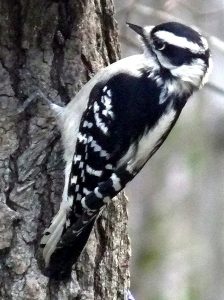 wingspan ranges in size from 9.5” to 11.5”. The Downy has a white breast and black and white checkered wings and back, with a broad, white strip running down the center of the back. The head is striped in black and white. Males may be identified by the red patch on the nape of the neck., sometimes referred to as a cap. The outside tail feathers are predominantly white with some black markings present. The tail feathers are stiff and are used to brace the woodpecker’s body when boring holes.
wingspan ranges in size from 9.5” to 11.5”. The Downy has a white breast and black and white checkered wings and back, with a broad, white strip running down the center of the back. The head is striped in black and white. Males may be identified by the red patch on the nape of the neck., sometimes referred to as a cap. The outside tail feathers are predominantly white with some black markings present. The tail feathers are stiff and are used to brace the woodpecker’s body when boring holes.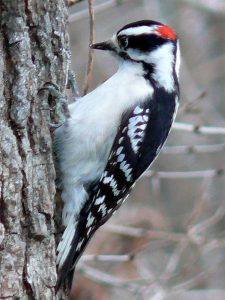 woodpecker is that this loud, rapid drumming is an attempt to bore for insects. This particular noise is actually used by the Downy to claim territory, maintain dominance or attract a mate. This particular drumming is steady and fast, approximately 17 beats a second. When excavating for food or to create a nest, the drum of the Downy tends to be slower, quieter and more deliberate in nature. The Downy also produces a short string of high notes lasting around two seconds. This shrill, descending whinny is made during mating season by both sexes6. The third noise is a high, short note made in excitement and called a pik.
woodpecker is that this loud, rapid drumming is an attempt to bore for insects. This particular noise is actually used by the Downy to claim territory, maintain dominance or attract a mate. This particular drumming is steady and fast, approximately 17 beats a second. When excavating for food or to create a nest, the drum of the Downy tends to be slower, quieter and more deliberate in nature. The Downy also produces a short string of high notes lasting around two seconds. This shrill, descending whinny is made during mating season by both sexes6. The third noise is a high, short note made in excitement and called a pik.